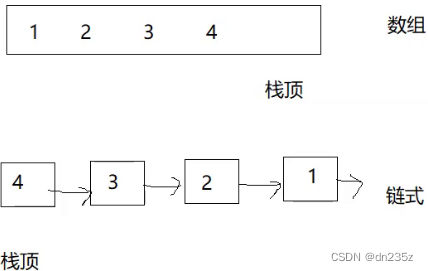-
栈和队列(8.4)
 1. 栈1.1 栈的概念及结构栈:一种特殊的线性表,其只允许在固定的一端进行插入和删除元素操作。 进行数据插入和删除操作的一端称为栈顶,另一端称为栈底。 栈中的数据元素遵守后进先出 LIFO ( Last In First Out )的原则。压栈:栈的插入操作叫做进栈 / 压栈 / 入栈, 入数据在栈顶 。出栈:栈的删除操作叫做出栈。 出数据也在栈顶 。
1. 栈1.1 栈的概念及结构栈:一种特殊的线性表,其只允许在固定的一端进行插入和删除元素操作。 进行数据插入和删除操作的一端称为栈顶,另一端称为栈底。 栈中的数据元素遵守后进先出 LIFO ( Last In First Out )的原则。压栈:栈的插入操作叫做进栈 / 压栈 / 入栈, 入数据在栈顶 。出栈:栈的删除操作叫做出栈。 出数据也在栈顶 。
后入栈的数据先出来,例如存入1,2,3,出栈的顺序是3,2,1。
1.2 栈的实现思考一下,栈的实现是用数组还是链表更合适呢?
都可以实现,但相对来说,数组更好一些,数组的尾插尾删效率更高。

typedef int STDataType;
//支持动态增长的栈
typedef struct Stack
{
STDataType* a;
int top;//栈顶
int capacity;//容量
}ST;1.2.1 栈初始化
存在一个问题,栈顶 top 应该初始化为多少?
如果初始化为 0,入栈一个数据 top ++,意味着 top 是栈顶元素的下一个位置

初始化为 -1, top 则为栈顶元素本身

这两种做法都是可以的。
完整代码:
头文件:- #pragma once
- #include
- #include
- #include
- #include
- //定义栈
- 静态栈(一般不用)
- //#define N 10
- //struct Stack
- //{
- // int a[N];
- // int top;
- //};
- typedef int STDataType;
- //支持动态增长的栈
- typedef struct Stack
- {
- STDataType* a;
- int top;//栈顶
- int capacity;//容量
- }ST;
- // 初始化栈
- void STInit(ST* ps);
- // 入栈
- void STPush(ST* ps, STDataType x);
- // 出栈
- void STPop(ST* ps);
- // 获取栈顶元素
- STDataType STTop(ST* ps);
- // 获取栈中有效元素个数
- int STSize(ST* ps);
- // 检测栈是否为空,如果为空返回非零结果,如果不为空返回0
- bool STEmpty(ST* ps);
- // 销毁栈
- void STDestroy(ST* ps);
测试文件:
- #define _CRT_SECURE_NO_WARNINGS 1
- #include"Stack.h"
- void TestStack1()
- {
- //初始化结构体
- ST st;
- STInit(&st);
- STPush(&st, 1);
- STPush(&st, 2);
- STPush(&st, 3);
- STPush(&st, 4);
- //链表不为空
- while (!STEmpty(&st))
- {
- //打印栈顶
- printf("%d ",STTop(&st));
- //打印一个,出栈一个
- STPop(&st);
- }
- printf("\n");
- STDestroy(&st);
- }
- int main()
- {
- TestStack1();
- return 0;
- }
实现文件:
- #define _CRT_SECURE_NO_WARNINGS 1
- #include"Stack.h"
- // 初始化栈
- void STInit(ST* ps)
- {
- assert(ps);
- ps->a = NULL;
- ps->capacity = 0;
- ps->top = 0;
- }
- // 销毁栈
- void STDestroy(ST* ps)
- {
- assert(ps);
- //释放
- free(ps->a);
- ps->a = NULL;
- ps->top = ps->capacity = 0;
- }
- // 入栈
- void STPush(ST* ps, STDataType x)
- {
- assert(ps);
- //如果放满,扩容
- if (ps->top == ps->capacity)
- {
- //如果容量为空,就先赋值,如果不为空,就将容量翻倍
- int newCapacity = ps->capacity == 0 ? 4 : ps->capacity * 2;
- //直接用realloc申请空间,当原本没有空间时,它等同于malloc
- //先用tmp承接开辟的空间,以免开辟失败破坏原空间
- STDataType* tmp = (STDataType*)realloc(ps->a,sizeof(STDataType) * newCapacity);
- if (tmp == NULL)
- {
- perror("realloc");
- exit(-1);
- }
- ps->a = tmp;
- ps->capacity = newCapacity;
- }
- //放值
- ps->a[ps->top] = x;
- ps->top++;
- }
- // 出栈
- void STPop(ST* ps)
- {
- assert(ps);
- //top为0说明栈空,不能继续删
- assert(ps->top > 0);
- --ps->top;
- }
- // 获取栈中有效元素个数
- int STSize(ST* ps)
- {
- assert(ps);
- //top是栈顶元素的下一个位置,正好是size
- return ps->top;
- }
- // 检测栈是否为空,如果为空返回非零结果,如果不为空返回0
- bool STEmpty(ST* ps)
- {
- assert(ps);
- //top为0栈为空
- return ps->top == 0;
- }
- // 获取栈顶元素
- STDataType STTop(ST* ps)
- {
- assert(ps);
- //top为0说明栈空,没有元素
- assert(ps->top > 0);
- return ps->a[ps->top - 1];
- }
例题:

思路:由于左括号需要以正确的顺序闭合,栈的特性完美适配这一要求:我们创建一个栈(栈的基本操作我们直接cv前面的代码),将左括号入栈,然后取栈顶,与栈外的右括号相匹配,如果刚好完全匹配没有剩余,则为有效,相反,左括号或右括号中任一有剩余则为无效。
- typedef char STDataType;
- //支持动态增长的栈
- typedef struct Stack
- {
- STDataType* a;
- int top;//栈顶
- int capacity;//容量
- }ST;
- // 初始化栈
- void STInit(ST* ps);
- // 入栈
- void STPush(ST* ps, STDataType x);
- // 出栈
- void STPop(ST* ps);
- // 获取栈顶元素
- STDataType STTop(ST* ps);
- // 获取栈中有效元素个数
- int STSize(ST* ps);
- // 检测栈是否为空,如果为空返回非零结果,如果不为空返回0
- bool STEmpty(ST* ps);
- // 销毁栈
- void STDestroy(ST* ps);
- // 初始化栈
- void STInit(ST* ps)
- {
- assert(ps);
- ps->a = NULL;
- ps->capacity = 0;
- ps->top = 0;
- }
- // 销毁栈
- void STDestroy(ST* ps)
- {
- assert(ps);
- //释放
- free(ps->a);
- ps->a = NULL;
- ps->top = ps->capacity = 0;
- }
- // 入栈
- void STPush(ST* ps, STDataType x)
- {
- assert(ps);
- //如果放满,扩容
- if (ps->top == ps->capacity)
- {
- //如果容量为空,就先赋值,如果不为空,就将容量翻倍
- int newCapacity = ps->capacity == 0 ? 4 : ps->capacity * 2;
- //直接用realloc申请空间,当原本没有空间时,它等同于malloc
- //先用tmp承接开辟的空间,以免开辟失败破坏原空间
- STDataType* tmp = (STDataType*)realloc(ps->a,sizeof(STDataType) * newCapacity);
- if (tmp == NULL)
- {
- perror("realloc");
- exit(-1);
- }
- ps->a = tmp;
- ps->capacity = newCapacity;
- }
- //放值
- ps->a[ps->top] = x;
- ps->top++;
- }
- // 出栈
- void STPop(ST* ps)
- {
- assert(ps);
- //top为0说明栈空,不能继续删
- assert(ps->top > 0);
- --ps->top;
- }
- // 获取栈中有效元素个数
- int STSize(ST* ps)
- {
- assert(ps);
- //top是栈顶元素的下一个位置,正好是size
- return ps->top;
- }
- // 检测栈是否为空,如果为空返回非零结果,如果不为空返回0
- bool STEmpty(ST* ps)
- {
- assert(ps);
- //top为0栈为空
- return ps->top == 0;
- }
- // 获取栈顶元素
- STDataType STTop(ST* ps)
- {
- assert(ps);
- //top为0说明栈空,没有元素
- assert(ps->top > 0);
- return ps->a[ps->top - 1];
- }
- bool isValid(char * s){
- ST st;
- char top;
- STInit(&st);
- while(*s)
- {
- //如果为左括号
- if(*s=='{'||*s=='('||*s=='[')
- {
- //入栈
- STPush(&st, *s);
- }
- //如果为右括号
- else
- {
- //栈内为空,说明左右括号数量不匹配
- if(STEmpty(&st))
- {
- //销毁空间,返回
- STDestroy(&st);
- return false;
- }
- //栈内不为空,取栈顶与栈外的右边括号匹配
- top=STTop(&st);
- //取出之后就出栈,以便于后面的元素出栈
- STPop(&st);
- //左右不匹配
- if(*s=='}'&&top!='{'
- ||*s==']'&&top!='['
- ||*s==')'&&top!='(')
- {
- STDestroy(&st);
- return false;
- }
- }
- s++;
- }
- //通过遍历说明右括号完全被匹配,栈内的左括号可能有剩余,没有剩余ture,有剩余false
- bool ret=STEmpty(&st);
- return ret;
- STDestroy(&st);
- }
-
相关阅读:
如何成为一个年薪188W的Java资深架构师成功的秘密,Java 面试题解析
单位固定资产应该怎么管理
记一次栈溢出异常问题的排查
社工工具演示
C++面试题准备
C++学习笔记——类与对象
STM32_SPI总线驱动OLED详细原理讲解
HCNP Routing&Switching之组播技术-组播分发
windows系统一键开启和关闭虚拟化
LeetCode41题:缺失的第一个正数(python3)
- 原文地址:https://blog.csdn.net/dn235z/article/details/133972842
